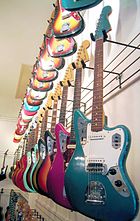Fender Jaguar
 |
|
| Manufacturer | Fender |
|---|---|
| Period | 1962–1975; 1999–present |
| Body type | Solid |
| Neck joint | Bolt-on |
| Scale | 24 in (610 mm) |
| Body | Usually Alder (basswood) |
| Neck | Maple |
| Fretboard | Usually Rosewood |
| Bridge | "Floating" proprietary vibrato unit Tune-o-matic |
| Pickup(s) | Usually two Single-coil |
| Various 2- or 3-color sunbursts Various shades of white, blue, red, green, etc. |
|
The Fender Jaguar is an electric guitar by Fender Musical Instruments characterized by an offset-waist body, a relatively unusual switching system with two separate circuits for lead and rhythm, and a medium-scale 24" neck. Owing some roots to the Jazzmaster, it was introduced in 1962 as Fender's feature-laden top-of-the-line model, designed to lure players from Gibson. During its initial 13-year production run, the Jaguar did not sell as well as the less expensive and Telecaster, and achieved its most noticeable popularity in the surf music scene. After the Jaguar was taken out of production in 1975, vintage Jaguars became popular first with punk rock players, and then more so during the alternative rock and indie rock movements of the 1980s and 90s. Fender began making a version in Japan in the mid-1980s, and then introduced a USA-made reissue in 1999. Since then, Fender has made a variety of Jaguars in America, Mexico, and China under both the Fender and Squier labels. Original vintage Jaguars sell for many times their original price.
Both the Fender company and vintage guitar authorities date the introduction of the Jaguar to 1962. One writer states that the model was introduced in December 1960, but a 1962 ad featuring a Jaguar automobile in the background referred to the "new" Fender Jaguar.
1960s advertising for the Jaguar often had beach themes, underscoring the guitar's appeal to surf musicians. Photographs for the campaign, done by Bob Perine, included photographs of bikini-clad girls on sandy beaches holding Jaguars—many of these featured Perine's daughter and her friends. The guitar was not, however, heavily publicized by surf players themselves, although The Beach Boys' Carl Wilson is featured in one early publicity photo.
The Jaguar never enjoyed the popularity of its Stratocaster and Telecaster siblings. After several upgrades—which included custom finishes, a bound neck, pearloid block inlays, maple fingerboard with black binding, and block inlays—the Jaguar was discontinued in December 1975 after a thirteen-year production run.
...
Wikipedia
